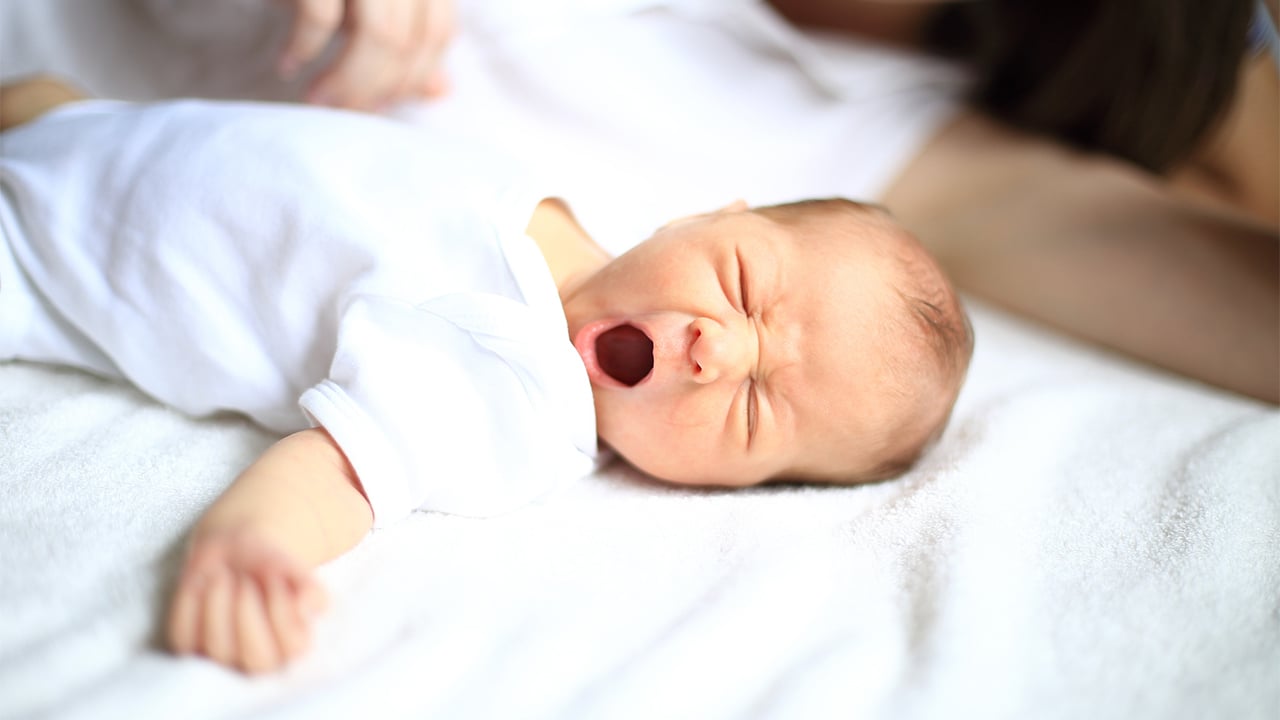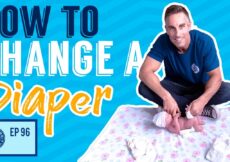After months of breastfeeding around the clock and diligently trying to put her infant son to sleep in his bassinet, Toronto mom Kate Galt was bone-tired. Nothing was working anymore. When Elliot outgrew the bassinet at three months old, Galt tried to train him to sleep in his own crib, but he always seemed to wind up in bed with her at some point in the night. It’s where he seemed happiest and most settled.
The truth is that Galt liked sleeping next to Elliot, too. “When I sleep with him at night, it makes me feel closer to him,” she says. As a child, she shared a bed with her sister, and snuggling up next to her loved ones at night feels natural to her. “I’ve always slept with people,” she says. “It feels sad to put a baby in bed by themselves. Like, I don’t want to sleep alone either!”
But North American experts and doctors adamantly recommend against co-sleeping with a baby. Both the Canadian Paediatric Society (CPS) and the American Academy of Pediatrics (AAP) have long advised new parents not to bed-share, warning that it’s dangerous and poses suffocation risks, along with a higher risk of sudden infant death syndrome (SIDS).
But when parents are desperate for just a few hours of sleep, bed-sharing does happen. Anyone who has brought their infant into their bed for a 3 a.m. feed knows how easy it is to doze off while nursing, with the baby in your arms, whether you mean to or not.
A recently updated joint statement on safe infant sleep, put out by the CPS and Health Canada last month, backs up what many parents have experienced first-hand: One third of Canadian mothers report bed-sharing regularly, and another third say they do so occasionally. A majority of Canadian parents are going to co-sleep at some point regardless of the advice, and regardless of best intentions. The new statement reflects that reality.
“We knew that we had to address the elephant in the room,” says April Kam, a CPS adviser and paediatric physician based in Hamilton, Ont.
Ultimately, Kam says that the safest place for infants to sleep is in a crib, cradle or bassinet, because bed-sharing increases the risk of suffocation and overheating. It’s the role of the CPS to be clear about where the risks of SIDS lie, says Kam, but it’s up to parents to choose what works best for their families, and the more information parents have, the better. This is why the joint statement was updated to include which behaviours, and which family circumstances, can put babies most at risk. According to the new statement, these risks are “particularly high for infants less than four months of age, or if the infant was born preterm or with low birthweight.” But if you’re still going to bed-share anyway, there are steps you can take to mitigate the risks.
If you can, breastfeed for at least two months
Research indicates that breastfeeding has been shown to reduce the risk of SIDS, says Kam. “Breastfeeding for at least two months is protective, and the longer you breastfeed, the more protective it is, up to a certain point.” When co-sleeping, however, Kam says that the benefits of breastfeeding or chest feeding do not fully negate the higher risks of bed sharing.
James McKenna, California-based anthropologist and author of the book Safe Infant Sleep, says that mothers sleeping next to their infants can be perfectly safe and even good for the baby as long as parents are careful. McKenna, who founded the Mother-Baby Behavioral Sleep Laboratory at the University of Notre Dame, studies the physiology and behaviour of co-sleeping mothers and infants. His research has led him to conclude that “the safest sleep environment is one that includes a breastfeeding mother.” He’s not saying this to shame those who cannot breastfeed, or choose not to nurse—it has more to do with the science of sleep and a baby’s wakefulness.
In the first three months, when babies are most susceptible to SIDS, all babies are prone to periods of sleep apnea in which they momentarily stop breathing, he explains. This is normal. When breastfed babies sleep next to their mother, “they’re waking up all night, and they’re getting practice in arousing to breathe,” he explains. “They’re getting really good at it.” By contrast, McKenna and his colleagues found that babies who slept on their own didn’t wake as frequently to break those periods of sleep apnea.
“There’s this whole notion that the ‘good’ baby is the baby who sleeps through the night and sleeps deeply, and that isn’t true,” says McKenna. “What makes the engagement between the mother and infant so important is a constant switching between sleep stages and arousal mechanisms that are oxygenating the baby.”
Beyond this arousal mechanism, McKenna and his researchers have observed that breastfeeding mothers sleep in what they call a C position.
“A lot of mothers will sleep on their side with the baby underneath the triceps at chest level, and pull up their legs underneath the feet of the baby,” McKenna says. This arrangement offers protection against moving around, when compared with non-breastfeeding babies, who tend to sleep further up toward the pillow, and not necessarily facing their mother. (Note that pillows should actually be removed from the bed altogether.)
Stay sober and smoke-free
Exposure to second-hand cigarette smoke during pregnancy and postpartum isn’t just frowned-upon—it has a very real impact on how your baby’s brain works, explains McKenna. The chemicals in the smoke damage the arousal sites in the brain that allow the baby to learn how to breathe properly overnight, and this increases the risk of SIDS.
“Smoking and bed sharing appear to have a synergistic effect,” reads the CPS statement. “The risk of SIDS is significantly higher for infants who bed-share with an adult who is a smoker, or if their mother smoked during pregnancy.”
The new position statement also points out that prenatal and continued use of alcohol, opioids and other substances (not just nicotine), are all associated with increased risk of SIDS, especially when bed-sharing. “Both the mother and the father should avoid desensitization by drugs or alcohol,” says McKenna.
If you’re going to co-sleep, make it a safe sleeping space
Kam stresses the importance of never putting a baby to sleep on a soft surface with loose bedding, which most typical adult beds contain. This means no blankets, no pillows, no duvets, no nursing pillows, and no bumpers. A firm mattress with a tight-fitting sheet is the only option. (No water beds, no air mattresses, and no pillow-top mattresses, either.)
Sidecar cribs that attach to the bed, or co-sleeper bassinets with a drop-down side, are also not recommended, because infants can become trapped in the gaps between the bed, the mattress and the co-sleeper. (In fact, these kinds of products are largely not available to buy in Canada.)
And avoid the whole “family bed” concept, too, adds Kam. Bed-sharing with other adults, older children and pets further increases the risks of sudden infant death. The safest way to co-sleep is to limit the bed to just parent and baby.
When Galt first decided to embrace co-sleeping, she wanted to make sure she was doing it as safely as possible. “I read all the things and made sure nothing was dangerous. We never drank or smoked weed. Elliot slept without pillows, without blankets, and so did I,” she says.
Finally, don’t sleep on a couch or in a chair with your baby in your arms, on your chest, or nestled next to you. “Co-sleeping on a couch or recliner is always dangerous,” says McKenna.
What about co-sleeping with a swaddled infant?
A well-fitting sleep sack is OK when co-sleeping, but never bed-share with a swaddled baby. The updated statement from the CPS also emphasizes that swaddling doesn’t reduce the risk of SIDS. In fact, Kam says swaddling can be dangerous in certain circumstances.
Regardless of where you put your baby down to sleep, “do not place a swaddled child on their side or their stomach, and discontinue swaddling if the infant is showing any signs of being able to roll,” says Kam. The swaddle should also be secured away from the baby’s mouth or nose, closer to the shoulders, and not bunched up near their chin or face. If you use a blanket as a swaddle, choose a lightweight one so as not to overheat the baby.
Can pacifiers help keep co-sleeping babies safe?
Yes, they can. There’s evidence that once breastfeeding is established, soothers can help keep babies safe, because the sucking triggers the breathing reflex and reduces those periods of newborn apnea, according to Kam.
Is room sharing safer than bed-sharing?
Room sharing is a good, protective option that keeps infants near their parents overnight, but not in the same bed, says Kam. (You can do this with a bassinet, travel crib or a regular crib, if you have the space in your bedroom. Or, some parents prefer to sleep on an adult-sized mattress in the nursery, next to the baby’s crib.) Room sharing is associated with a lower risk of SIDS and recommended for the first six months of life.
Because SIDS risks peak between two and four months, and it happens less often between six and 12 months, parents can relax a little as their babies get older.
“As with most aspects of parenting, as the child ages, you can continue to modify and adjust to their developmental stages,” Kam says. Once your baby learns to roll over, for example, you can stress less about making sure they’re sleeping on their back—let them sleep on their tummies if they got there on their own.
Ultimately, there are a myriad of factors that affect safety and raise or lower the risks to the baby. It is certainly possible to make bed-sharing safer, but it still does carry an elevated risk of SIDS. Remember that the safest co-sleeping arrangement is between a sober and smoke-free breastfeeding mother and her infant, in a firm bed, without loose bedding. Any departure from that increases the risks of sudden infant death, says Kam.
She likes to use a cycling safety analogy: “Consider all the layers of protection we wear on our bike. Maybe we’d be safe with only some of those, and maybe we’d make it through with none. But it makes sense to protect ourselves as well as we can.” She says that parents have to do the best they can day-to-day, and her job is simply to make sure they’re as educated as they can be about the risk factors.
Baby Elliot is now almost two, and still bed- sharing with his mom. “I only see him for an hour or two in the morning and at night, so sleeping is the longest time we have together on many days,” Galt says. She’s completely sold on co-sleeping now and will definitely continue with future babies. “I know it’s taboo,” she says. “I thought we were going to do sleep training, because that’s the ‘right’ thing to do. But those first few months are freaking hell. And if you do all the research on co-sleeping, it can be done safely, in my opinion, and lead to better rest for everyone.”



































